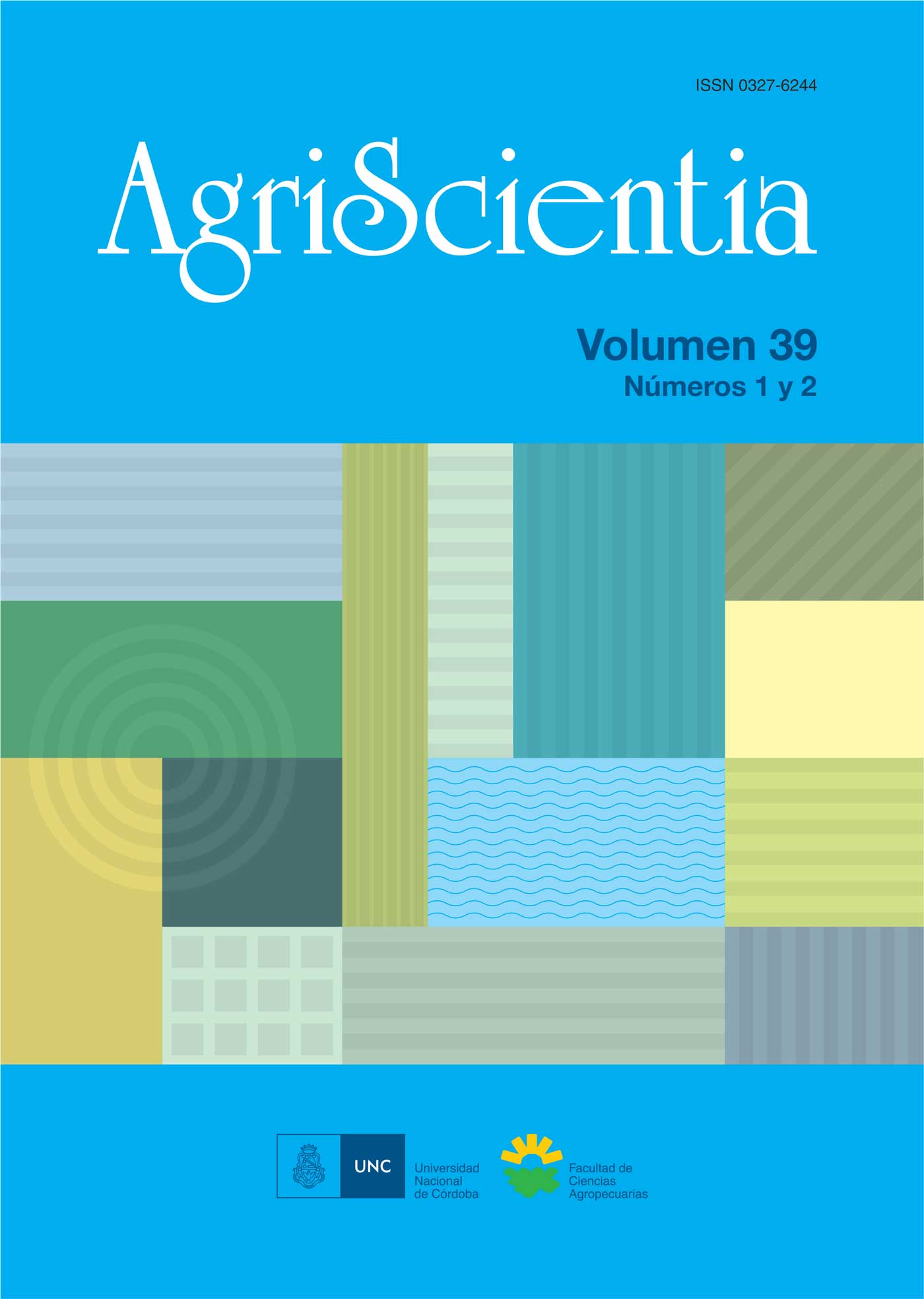Años requeridos para la evaluación a campo de cultivares comerciales de trigo pan en Argentina
Contenido principal del artículo
Resumen
En Argentina, la normativa vigente establece cuatro años de evaluación de rendimiento para cualquier nuevo cultivar comercial de trigo pan. El objetivo de este trabajo fue determinar la cantidad óptima de años de evaluación en ensayos comparativos de rendimiento de cultivares de trigo pan, condicionando dicho óptimo al grupo de calidad, ciclo de crecimiento y manejo fitosanitario. Se estimaron componentes de varianza (REML) con los datos de la Red de evaluación de cultivares de trigo pan de Argentina (RET), correspondientes a diez sitios experimentales. Se consideraron los tres grupos de calidad (GC1, GC2 y GC3), la primera y tercera época de siembra (E1 y E3), y manejo con y sin fungicida (CF y SF). Los resultados muestran que se requieren tres años de ensayos para evaluar el rendimiento de los diferentes grupos de calidad y ciclos de crecimiento manejados CF. Para el SF, se requieren cuatro años, excepto para GC1 en E3 y GC2 en E1, que demandan tres y más de cinco años, respectivamente. Estos resultados indican que la norma actual es apropiada para la mayoría de los casos; incluso, podría reducirse a tres CF, para mejorar la calidad de los ensayos y aumentar el número de repeticiones.
Detalles del artículo

Esta obra está bajo una licencia internacional Creative Commons Atribución-CompartirIgual 4.0.
Cómo citar
Referencias
Abbate, P. E. (2018). ¿Qué es “la RET”? INTA. Ministerio de Agroindustria, Presidencia de la Nación. https://doi.org/10.13140/RG.2.2.25496.03845
Abbate, P. E. (2019). Índice de calidad de trigo pan método 2019 [Documento digital]. INASE. Disponible en: t.ly/zlRP
Abbate, P., Miralles, D. y Ballesteros, A. (2021). Nuevo mapa de subregiones trigueras argentinas y de otros cereales invernales 2021. INASE. Ministerio de Agricultura, Ganadería y Pesca, Presidencia de la Nación. https://doi.org/10.13140/RG.2.2.21236.48000
Aguate, F., Crossa, J. y Balzarini, M. (2019). Effect of Missing Values on Variance Component Estimates in Multienvironment Trials. Crop Science, 59(2), 508–517. https://doi.org/10.2135/cropsci2018.03.0209
Arief, V. N., DeLacy, I. H., Crossa, J., Payne, T., Singh, R., Braun, H. J., Tian, T., Basford, K. E. y Dieters, M. J. (2015). Evaluating Testing Strategies for Plant Breeding Field Trials: Redesigning a CIMMYT International Wheat Nursery. Crop Science, 55(1), 164–177. https://doi.org/10.2135/cropsci2014.06.0415
Balzarini, M. (2002). Applications of mixed models in plant breeding. En M. S. Kang (Ed.), Quantitative genetics, genomics and plant breeding (2da Ed., 353–363). CABI: Digital Library. https://doi.org/10.1079/9780851996011.0353
Baxevanos, D., Korpetis, E., Irakli, M. y Tsialtas, I. Τ. (2017). Evaluation of a durum wheat selection scheme under Mediterranean conditions: adjusting trial locations and replications. Euphytica, 213(4), 82. https://doi.org/10.1007/s10681-017-1871-y
Falconer, D. y Mackay, T. (1996). Introduction to Quantitative Genetics (4a Ed.). Longman.
Fehr, W. (1991). Principles of Cultivar Development: Theory and Technique. Agronomy Book1. Digital Repository: Iowa State University. https://core.ac.uk/download/pdf/212817093.pdf
Instituto Nacional de Semillas (INASE) (2003). Resolución 323/2003. Crease la red de ensayos comparativos de variedades de trigo (RET) en el ámbito de la Secretaría de Agricultura, Ganadería, Pesca y Alimentos dependiente del Ministerio de Economía y Producción. Boletín Oficial de la República Argentina, Primera Sección, 30175, 6.
Martínez-Rueda, C. G. y López-Castañeda, C. (2004). Eficiencia de la selección indirecta en el mejoramiento de trigo para condiciones limitantes y no limitantes de humedad. Revista Fitotecnia Mexicana, 27(2), 191–199. https://doi.org/10.35196/rfm.2004.2.191
Miranda, R. y Salomón N. (2001). Índice de calidad como herramienta para determinar la aptitud de los materiales genéticos. En M. M Kohli, M. D. Ackermann y M.D. de Castro (Eds.), Estrategias y metodologías utilizadas en el mejoramiento de trigo (163-173). Ed. Hemisferio Sur.
Montgomery, D. C. (2004). Diseño y análisis de experimentos (2daEd.). Grupo Noriega Editores.
Patterson, H. D., Silvey, V., Talbot, M. y Weatherup, S. T. C. (1977). Variability of yields of cereal varieties in U. K. trials. The Journal of Agricultural Science, Cambridge, 89(1), 239–245.
SAS Institute Inc. (2020). SAS Studio (3.8 EnterpriseEdition) [Software]. SAS OnDemand for Academics. https://welcome.oda.sas.com/login
Woyann, L. G., Zdziarski, A. D., Zanella, R., Rosa, A. C., Conte, J., Meira, D., Storck, L. y Benin, G. (2020). Optimal number of replications and test locations for soybean yield trials in Brazil. Euphytica, 216(1), 11. https://doi.org/10.1007/s10681-019-2548-5
Yan, W. (2013). Biplot Analysis of Incomplete Two-Way Data. Crop Science, 53(1), 48–57. https://doi.org/10.2135/cropsci2012.05.0301
Yan, W., Frégeau-Reid, J., Martin, R., Pageau, D. y Mitchell-Fetch, J. (2015). How many test locations and replications are needed in crop variety trials for a target region? Euphytica, 202(3), 361–372. https://doi.org/10.1007/s10681-014-1253-7





